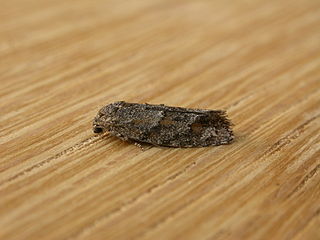
Agriophara nodigera is a moth of the family Depressariidae. It is found in Australia, where it has been recorded from Queensland.
Microcolona transennata is a moth in the family Elachistidae. It is found in Brazil (Para) and Peru.
Dichomeris corniculata is a moth in the family Gelechiidae. It was described by Edward Meyrick in 1913. It is found in Assam, India and Guangdong, China.
Anacampsis considerata is a moth of the family Gelechiidae. It was described by Edward Meyrick in 1922. It is found in Brazil (Amazonas) and Peru.
Anacampsis peloptila is a moth of the family Gelechiidae. It was described by Edward Meyrick in 1914. It is found in Guyana.
Photodotis prochalina is a moth of the family Gelechiidae. It was described by Edward Meyrick in 1911. It is found in South Africa.
Antaeotricha lophosaris is a species of moth of the family Depressariidae. It is found in Brazil.
Stenoma ancylacma is a species of moth of the family Depressariidae. It is found in Peru.
Antaeotricha iras is a species of moth of the family Depressariidae. It is found in Peru.
Antaeotricha balanocentra is a species of moth of the family Depressariidae. It is found in Guyana.
Antaeotricha sparganota is a moth of the family Depressariidae first described by Edward Meyrick in 1915. It is found in Guyana.
Antaeotricha himaea is a species of moth of the family Depressariidae. It is found in French Guiana.
Psittacastis trierica is a moth in the family Depressariidae. It was described by Edward Meyrick in 1909. It is found in Bolivia.
Hypercallia alexandra is a moth in the family Depressariidae. It was described by Edward Meyrick in 1909. It is found in Peru.
Antaeotricha aglypta is a species of moth in the family Depressariidae. It was described by Edward Meyrick in 1925. It is found in Guyana and Brazil.
Antaeotricha gymnolopha is a species of moth in the family Depressariidae. It was described by Edward Meyrick in 1925. It is found in Brazil.
Antaeotricha encyclia is a species of moth in the family Depressariidae. It was described by Edward Meyrick in 1915. It is found in Colombia.
Imma halonitis is a moth in the family Immidae. It was described by Edward Meyrick in 1920. It is found in Chennai, India.
Moca aphrodora is a species of moth in the family Immidae first described by Edward Meyrick in 1922. It is found in Brazil and Peru.
Imma eriospila is a species of moth in the family Immidae. It was described by Edward Meyrick in 1922. It is found in Pará, Brazil.
